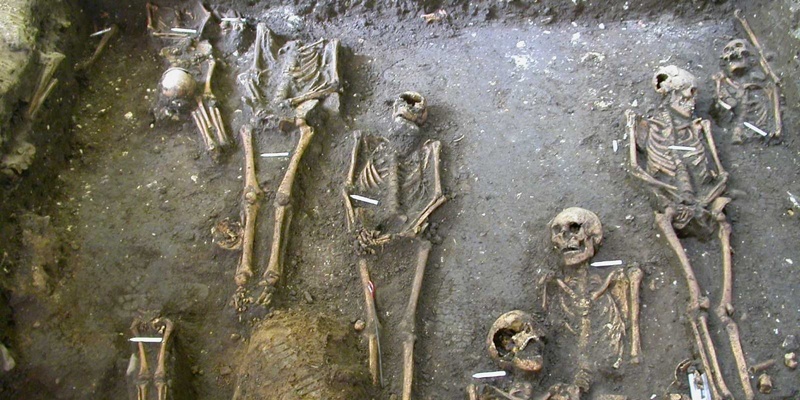Roadworks in St Andrews town centre have been halted following the discovery of a number of human skeletons.
It is thought the remains are those of 15th century Franciscan monks known to have lived in the town. The find just six inches below the road’s surface has excited Fife Council archaeologist Douglas Speirs, who has long tried to pinpoint the exact location of the monks’ ancient burial ground.
The resurfacing work in Greyfriars Gardens has been temporarily abandoned to allow the site to be excavated and the remains preserved.
”St Andrews is a town of considerable antiquity so we always held the possibility of archaeological remains coming to light in that area as part of these works,” Mr Speirs said. ”However, we thought that because they were only reducing the surface by a small margin it wouldn’t be deep enough to disturb anything. Clearly we were wrong.”
The archaeologist said it was ”abundantly obvious” that the ground level had reduced significantly over the last 200 years, meaning the bones were much closer to the surface than expected.
”We’ve just uncovered them now and we’ve stopped work in that area,” he said. ”These are human remains in consecrated ground so they must be treated with proper dignity. We’ve covered everything over and we’re trying to draw as little attention to the site as possible.”
Mr Speirs is almost certain that workers have discovered part of a cemetery used by a small order of Franciscan friars in the 15th century.
”A Franciscan friary is known to have existed somewhere in the near vicinity and because of their order they weren’t buried in the local cemetery but had their own little one,” he said. ”The exact footprint of the friary is not known and previous archaeological works in the area have failed to locate it.
”However, there can be little doubt that today’s discovery represents part of the cemetery of the friary of Observant Franciscans established in the town with the encouragement of Bishop Kennedy in 1458.
”The human remains exposed have now been recorded and excavated although development works on this part of the site has been stopped to allow for further investigations and recording works to be undertaken by Fife Council’s archaeological unit.”
The objective now is to confirm the extent and condition of the cemetery. Despite the installation of water and gas pipes, as well as electricity and phone cables, it is hoped some meaningful results will be revealed by the excavations.
The friary was a relatively late development in medieval St Andrews and archaeologists will now look to see if traces of the earlier use of the site can be identified. Skeletal analysis should reveal more about the lives and deaths of the individuals uncovered.
All of them are likely to have been made Franciscan friars.
Mr Speirs said: ”I strongly suspect that radiocarbon dates will fall into the period 1458 to 1559 as we know from historical documentation that the friary was founded in 1458, completed in 1478 under Archbishop Graham and that it was an early casualty of the Reformation, being ransacked in early 1559.”
The latest discovery follows a number of recent important archaeological projects in St Andrews. These are shedding significant new light on the earliest origins, organisation and evolution of one of Scotland’s most ancient towns.
Last summer’s Market Street road resurfacing project revealed early deposits in the very heart of the burgh. House renovations in South Street are revealing some of the earliest upstanding medieval townhouse remains in Scotland, along with some very important medieval pottery.
”All of these investigations are slowly but surely shedding valuable new light on the origins of medieval St Andrews and, more importantly, they are challenging many long held views, allowing a new history of the town’s medieval past to be written,” Mr Speirs said.
